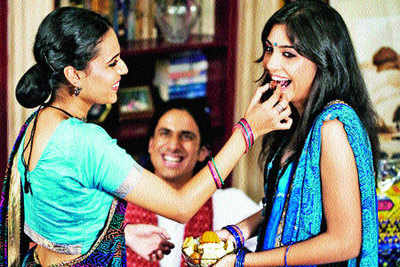Trending
This story is from August 17, 2014
The street of sweet beginnings
TOI takes a trip down the khowa gully, the one-stop street mall for all your sweet needs.

TOI takes a trip down the khowa gully, the one-stop street mall for all your sweet needs.
Raksha Bandan kicked off the season of festivities set to continue till Diwali. The one thing that is common to all the festivals are the slurp inducing mithai.
And what is an Indian sweet without khowa — thickened milk base which lends itself to a multitude of flavours and textures? And when talking about khowa in Hyderabad, there is only one address: Shahalibanda.
Barely a hundred metres from Charminar, you enter the lane, under an arch and you are greeted with that sticky sweet smell of milk. It’s a street filled with shops selling khowa virtually spilling onto the road. If your eyes wander towards one or the other shop, you will be immediately beckoned inside.
What is cheese to continental palate, this is the Indian equivalent as the range and offering varies according to the needs. Even the texture counts with the fat content giving it a smooth texture and sometimes the graininess of the khowa is also in demand.
“To say this is the best place to get khowa in Hyderabad would be an understatement. There is amazing choice and price is much lower than the retailers and there is an element of guarantee that the stuff is good because the shop owners remain here,” says a shopper. There are about 40 shops in the vicinity catering to a regular clientele. Festive season sees a spike in the price while at other times the price stays stable at about 150 per kg.
But why has Shahalibanda become the khowa hotspot of the city? To answer the question we have to delve into a little food history. Shahalibanda is located at the exact spot of Chichilam village from where Bagamma aka Bagmati came and met Mohammed Quli Qutb Shah. Once Charminar was built, this area housed the royal dairy along with other small scale activities. The fall of Golconda changed the face of this area completely when it became home to leading Paigah families and Kayasths who came along with Aurangazeb. Before being called Khowa Gulli, it was known as Maharaja Peshkar Devdi street. The devdi was constructed in 1802 by Raja Chandulal, it was his great grandson Kishen Prashad who expanded it in a big way giving the name to the locality. The devdi had a stable for elephants as well as a garage for cars. Now, it appears like a run-down locality with the shops selling khowa and milk as the only claim to fame.
“Many people don’t know the magic of a khowa gulab jamun, they are happy to make them with the premixes that are available. But, once you make them with khowa, they just melt in your mouth. And the family just loves them, even if it means a drive through the crowded streets of Charminar,” says Supraja, a housewife from Attapur.
A little away from the street, you can bite into malai kebab. It has an element of sweetness to it that comes through the tang and bite of the masala. But khowa is not supposed to be sweet? “When the khowa is not adulterated it will be sweet. Only when it is adulterated that it loses its sweetness,” says the kebabwalla.
Raksha Bandan kicked off the season of festivities set to continue till Diwali. The one thing that is common to all the festivals are the slurp inducing mithai.
And what is an Indian sweet without khowa — thickened milk base which lends itself to a multitude of flavours and textures? And when talking about khowa in Hyderabad, there is only one address: Shahalibanda.
Barely a hundred metres from Charminar, you enter the lane, under an arch and you are greeted with that sticky sweet smell of milk. It’s a street filled with shops selling khowa virtually spilling onto the road. If your eyes wander towards one or the other shop, you will be immediately beckoned inside.
Enter and you will be offered a lump from the nearest vessel. The rounded heaps look similar, some white, some brown and others have a reddish tinge. “We offer this so that the person purchasing can make his choice. Some look for the bland version which is good for kheer, double ka meetha and kala jamoon. The slightly salty version is good for making gulab jamun,” says Ahmed bhai, who inherited this shop from his father Mehmood Ahmed. “The blander version which is white, is made from buffalo milk, while the salty variant, which is browner or of reddish hue, is made with cow milk,” he adds.
What is cheese to continental palate, this is the Indian equivalent as the range and offering varies according to the needs. Even the texture counts with the fat content giving it a smooth texture and sometimes the graininess of the khowa is also in demand.
“To say this is the best place to get khowa in Hyderabad would be an understatement. There is amazing choice and price is much lower than the retailers and there is an element of guarantee that the stuff is good because the shop owners remain here,” says a shopper. There are about 40 shops in the vicinity catering to a regular clientele. Festive season sees a spike in the price while at other times the price stays stable at about 150 per kg.
But why has Shahalibanda become the khowa hotspot of the city? To answer the question we have to delve into a little food history. Shahalibanda is located at the exact spot of Chichilam village from where Bagamma aka Bagmati came and met Mohammed Quli Qutb Shah. Once Charminar was built, this area housed the royal dairy along with other small scale activities. The fall of Golconda changed the face of this area completely when it became home to leading Paigah families and Kayasths who came along with Aurangazeb. Before being called Khowa Gulli, it was known as Maharaja Peshkar Devdi street. The devdi was constructed in 1802 by Raja Chandulal, it was his great grandson Kishen Prashad who expanded it in a big way giving the name to the locality. The devdi had a stable for elephants as well as a garage for cars. Now, it appears like a run-down locality with the shops selling khowa and milk as the only claim to fame.
“Many people don’t know the magic of a khowa gulab jamun, they are happy to make them with the premixes that are available. But, once you make them with khowa, they just melt in your mouth. And the family just loves them, even if it means a drive through the crowded streets of Charminar,” says Supraja, a housewife from Attapur.
A little away from the street, you can bite into malai kebab. It has an element of sweetness to it that comes through the tang and bite of the masala. But khowa is not supposed to be sweet? “When the khowa is not adulterated it will be sweet. Only when it is adulterated that it loses its sweetness,” says the kebabwalla.
End of Article
FOLLOW US ON SOCIAL MEDIA









